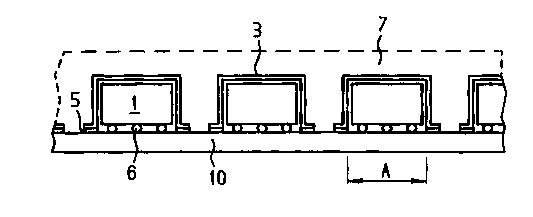Some of the information on this Web page has been provided by external sources. The Government of Canada is not responsible for the accuracy, reliability or currency of the information supplied by external sources. Users wishing to rely upon this information should consult directly with the source of the information. Content provided by external sources is not subject to official languages, privacy and accessibility requirements.
Any discrepancies in the text and image of the Claims and Abstract are due to differing posting times. Text of the Claims and Abstract are posted:
| (12) Patent Application: | (11) CA 2321473 |
|---|---|
| (54) English Title: | PROCESS FOR MANUFACTURING AN ELECTRONIC COMPONENT, IN PARTICULAR A SURFACE-WAVE COMPONENT WORKING WITH ACOUSTIC SURFACE WAVES |
| (54) French Title: | PROCEDE DE PRODUCTION D'UN COMPOSANT ELECTRONIQUE, EN PARTICULIER D'UN COMPOSANT A ONDES DE SURFACE FONCTIONNANT AVEC DES ONDES DE SURFACE ACOUSTIQUES |
| Status: | Deemed Abandoned and Beyond the Period of Reinstatement - Pending Response to Notice of Disregarded Communication |
| (51) International Patent Classification (IPC): |
|
|---|---|
| (72) Inventors : |
|
| (73) Owners : |
|
| (71) Applicants : |
|
| (74) Agent: | SMART & BIGGAR LP |
| (74) Associate agent: | |
| (45) Issued: | |
| (86) PCT Filing Date: | 1999-02-05 |
| (87) Open to Public Inspection: | 1999-08-26 |
| Availability of licence: | N/A |
| Dedicated to the Public: | N/A |
| (25) Language of filing: | English |
| Patent Cooperation Treaty (PCT): | Yes |
|---|---|
| (86) PCT Filing Number: | PCT/DE1999/000307 |
| (87) International Publication Number: | WO 1999043084 |
| (85) National Entry: | 2000-08-17 |
| (30) Application Priority Data: | ||||||
|---|---|---|---|---|---|---|
|
In a process for manufacturing a surface-wave filter, a carrier plate 10 which
can be subdivided into base plates 2 is provided with printed circuits in each
base plate zone A and these are contacted with the active structures of
surface-wave chips 1 by a flip-chip technique. A metal or plastic foil 3 or 4
is then laid on the carrier plate 10 fitted with chips and then processed
under heat and pressure, for example, so that each chip 1 - except for the
chip surface facing the carrier plate 10 - is enveloped and hermetically
sealed on the carrier plate surface in the zones between the chips.
L'invention concerne un procédé de production d'un filtre à ondes de surface, selon lequel une plaque de support (10) pouvant être divisée en plaques de base (2) est pourvue dans chaque zone de plaque de base (A) de pistes conductrices qui sont mises en contact, selon la technique de la connexion par billes, avec les structures actives de puces à ondes de surface, un film de métal ou de matière plastique (3 ou 4) étant ensuite appliqué sur la plaque de support (10) équipée de puces et, par exemple, traité à la vapeur ou thermiquement de telle sorte qu'il enveloppe chaque puce (1), exceptée la surface de puce tournée vers la plaque de support (10), et qu'il repose, dans les zones comprises entre les puces, de façon hermétique sur la surface de la plaque de support.
Note: Claims are shown in the official language in which they were submitted.
Note: Descriptions are shown in the official language in which they were submitted.

2024-08-01:As part of the Next Generation Patents (NGP) transition, the Canadian Patents Database (CPD) now contains a more detailed Event History, which replicates the Event Log of our new back-office solution.
Please note that "Inactive:" events refers to events no longer in use in our new back-office solution.
For a clearer understanding of the status of the application/patent presented on this page, the site Disclaimer , as well as the definitions for Patent , Event History , Maintenance Fee and Payment History should be consulted.
| Description | Date |
|---|---|
| Inactive: IPC from MCD | 2006-03-12 |
| Inactive: IPC from MCD | 2006-03-12 |
| Application Not Reinstated by Deadline | 2004-02-05 |
| Time Limit for Reversal Expired | 2004-02-05 |
| Deemed Abandoned - Failure to Respond to Maintenance Fee Notice | 2003-02-05 |
| Letter Sent | 2001-01-03 |
| Inactive: Single transfer | 2000-11-27 |
| Inactive: Cover page published | 2000-11-27 |
| Inactive: First IPC assigned | 2000-11-22 |
| Inactive: Courtesy letter - Evidence | 2000-11-14 |
| Inactive: Notice - National entry - No RFE | 2000-11-08 |
| Application Received - PCT | 2000-11-02 |
| Application Published (Open to Public Inspection) | 1999-08-26 |
| Abandonment Date | Reason | Reinstatement Date |
|---|---|---|
| 2003-02-05 |
The last payment was received on 2002-01-21
Note : If the full payment has not been received on or before the date indicated, a further fee may be required which may be one of the following
Please refer to the CIPO Patent Fees web page to see all current fee amounts.
| Fee Type | Anniversary Year | Due Date | Paid Date |
|---|---|---|---|
| Basic national fee - standard | 2000-08-17 | ||
| Registration of a document | 2000-11-27 | ||
| MF (application, 2nd anniv.) - standard | 02 | 2001-02-05 | 2001-01-19 |
| MF (application, 3rd anniv.) - standard | 03 | 2002-02-05 | 2002-01-21 |
Note: Records showing the ownership history in alphabetical order.
| Current Owners on Record |
|---|
| EPCOS AG |
| Past Owners on Record |
|---|
| ALOIS STELZL |
| HANS KRUGER |
| PETER DEMMER |